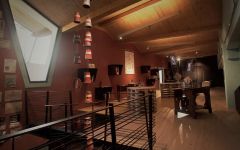Oddero Barolo Bussia Vigna Mondoca Riserva (1.5L Magnum) 2012
-
James
Suckling -
Wine
Spectator



Product Details
Your Rating
Somm Note
Winemaker Notes
Mellow and elegant bouquet with scents of berries and natural balsamic notes, Mediterranean woodlands and dried rose reminiscent of goudron with ageing. Well-balanced on the palate with elegant and assertive tannic texture, long and complex finish.
Professional Ratings
-
James Suckling
The purity of fruit here is stunning. A cascade of all kinds of fruit tea precedes a fanfare of blueberry peel, bright lemons, heather, freshly pressed lavender, orange rind and grapefruit skin. Full body, bright acidity and layered fruit that’s taken on a long, seemingly endless ride on the finish. So refined and delicate yet powerful and forthcoming.
-
Wine Spectator
Shows cherry and plum flavors, offering coconut, vanilla and toasty notes. Tar and leather accents peek through as this red settles into a long finish, with dusty tannins. An oaky style.
Other Vintages
2013-
Robert
Parker -
Wine
Spectator -
James
Suckling





This winery was founded in 1878, in the area of Santa Maria, a hamlet of La Morra. It is one of the oldest producers of Barolo, a family that has kept the distinctive traditional style of winemaking for over a century. Over the generations, the Oddero family has gradually expanded its vineyards to today's impressive 60 hectares, many of which lie in the illustrious Barolo vineyards of Brunate, Rocche di Castiglione, Villero and Mondoca di Bussia. Since 2001, with the help of young and talented winemaker Luca Vaglio, Oddero winery has become one of the leading producers in Barolo.

Responsible for some of the most elegant and age-worthy wines in the world, Nebbiolo, named for the ubiquitous autumnal fog (called nebbia in Italian), is the star variety of northern Italy’s Piedmont region. Grown throughout the area, as well as in the neighboring Valle d’Aosta and Valtellina, it reaches its highest potential in the Piedmontese villages of Barolo, Barbaresco and Roero. Outside of Italy, growers are still very much in the experimentation stage but some success has been achieved in parts of California. Somm Secret—If you’re new to Nebbiolo, start with a charming, wallet-friendly, early-drinking Langhe Nebbiolo or Nebbiolo d'Alba.

The center of the production of the world’s most exclusive and age-worthy red wines made from Nebbiolo, the Barolo wine region includes five core townships: La Morra, Monforte d’Alba, Serralunga d’Alba, Castiglione Falletto and the Barolo village itself, as well as a few outlying villages. The landscape of Barolo, characterized by prominent and castle-topped hills, is full of history and romance centered on the Nebbiolo grape. Its wines, with the signature “tar and roses” aromas, have a deceptively light garnet color but full presence on the palate and plenty of tannins and acidity. In a well-made Barolo wine, one can expect to find complexity and good evolution with notes of, for example, strawberry, cherry, plum, leather, truffle, anise, fresh and dried herbs, tobacco and violets.
There are two predominant soil types here, which distinguish Barolo from the lesser surrounding areas. Compact and fertile Tortonian sandy marls define the vineyards farthest west and at higher elevations. Typically the Barolo wines coming from this side, from La Morra and Barolo, can be approachable relatively early on in their evolution and represent the “feminine” side of Barolo, often closer in style to Barbaresco with elegant perfume and fresh fruit.
On the eastern side of the Barolo wine region, Helvetian soils of compressed sandstone and chalks are less fertile, producing wines with intense body, power and structured tannins. This more “masculine” style comes from Monforte d’Alba and Serralunga d’Alba. The township of Castiglione Falletto covers a spine with both soil types.
The best Barolo wines need 10-15 years before they are ready to drink, and can further age for several decades.
